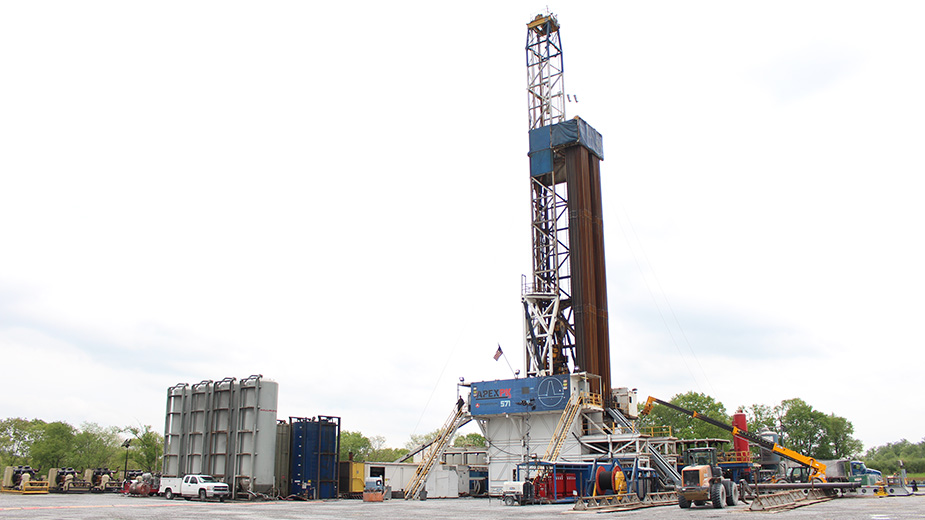Specialists See Value in Keeping Shale Gas Local
PITTSBURGH – Officials say the best way to attract new development and investment to the shale-rich Appalachian Basin is to collectively market its oil and gas assets to end users, while striving to keep as much of those resources within the region as possible.
This requires interstate cooperation between Pennsylvania, Ohio, and West Virginia, panelists said Thursday during a discussion on how to best leverage the region’s energy assets at Shale Insight 2017, held at Pittsburgh’s David L. Lawrence Convention Center.
The Marcellus Shale Coalition, the Ohio Oil and Gas Association, and the West Virginia Oil and Natural Gas Association hosted the event this year.
Natural gas-fueled electrical generation plants, additional ethane cracker plants and energy intensive manufacturing operations could all benefit from the low cost of natural gas flowing from the Utica and Marcellus shale plays.
Yet the region is still well behind the curve when it comes to infrastructure, and one key concept that could help boost investment from the petrochemicals industry is a vast hydrocarbon storage hub that could store and supply hydrocarbons such as ethane and butane to feed these operations. Such a massive project would benefit residents of Ohio, Pennsylvania, West Virginia and Kentucky.
“If each state by itself has its own tactics to answer today’s problems, without a strategic solution for the Appalachian Basin collaboratively, we don’t win,” said Steve Hedrick, president and CEO of Matric, a company that specializes in chemical research and development.
A tri-state memorandum of understanding between Pennsylvania, Ohio and West Virginia has existed since 2015, added Denise Brinley, senior energy advisor for the Pennsylvania Department of Community and Economic Development. “We’ve been on conference calls every two weeks talking about these issues,” she noted.
“The most important opportunity that has arisen is the need for a natural gas storage hub,” she said, a development that is critical to developing additional ethane crackers aside from Royal Dutch Shell’s $6 billion project near Monaca, Pa., along the Ohio River.
PTT Global Chemical, for example, is considering building a similar plant along the river in Belmont County, Ohio, Brinley said, but there might be others looking at the region, too. “We need a way to store ethane that is similar to the Gulf Coast,” she said, referencing several studies.
Matt Higham, chief financial officer of Denver-based Energy Storage Ventures, said that his company’s subsidiary, Mountaineer NGL Storage LLC, is preparing to build an underground storage facility in Monroe County, Ohio, not far from where PTT Global is weighing its proposed ethane plant.
“We’re trying to finalize our permits and initial contracts,” he said. “Once we have the permits and the right contracts, we’ll start building out the initial caverns.” The capital investment on the project, he added, is more than $100 million and could grow in the next 10 years.
Higham, who did not sit on the panel but attended Thursday’s conference, said that the company owns 200 acres along the Ohio River.
“We’ll create individual caverns capable of holding a half-million barrels,” of natural gas liquids. Each cavern would be carved out of a salt formation 6,700 feet below the earth’s surface. The first phases would hold about three million barrels total. “Each well will be a dedicated cavern.”
Ethane or other NGLs can be transported to the underground storage basins through pipeline, truck or rail, Higham said. Then, the storage hub would act as a sort of warehouse to supply petrochemical plants or other industries that might require that feedstock.
“We’re that bridge between midstream and downstream,” Higham said. “It keeps liquids in the region and supports economic development and projects.”
As it stands now, ethane and other NGLs are pulled from Appalachia and sent to large processors in the Gulf Coast or to Marcus Hook on the East Coast and then sent overseas, Higham said. “We’re a means to help keep it in the region.”
Ethane is among the more valuable wet gasses drilled from the Utica and Marcellus. The product is transported from midstream processing plants to end-users such as an ethane cracker, which then further processes the gas into polyethylene pellets. These pellets are used as a base ingredient for everyday plastics products.
Meanwhile, construction continues on Shell’s $6 billion ethane cracker in Beaver County, Pa., on the former Horsehead Zinc industrial site. “All of this investment by Shell is bringing jobs to the region,” said Michael Marr, business integration lead for Shell Appalachia.
Todd Whittemore, global technology manager for polyethylene for Shell Global Solutions U.S. Inc., said over the next several years, the landscape of the site should change dramatically. “The focus of the last year has been getting the undergrounds in – cooling water, piping, sewers – and now we’re starting some of the large foundations,” he said.
By next year, Shell will start to build some of the major structures, and “the whole skyline will change,” Whittemore said. It will still take another two more years or so to complete all of the internal pipeline connections within the massive plant before it is commissioned.
At the height of construction, about 6,000 tradesmen will be employed on the project and the plant will employ 600 full-time once it is operational.
The Monaca plant is Shell’s first new site since the late 1960s, Whittemore said.
Shell’s cracker is likely to stimulate other jobs in the market as well, said David Ruppersberger, president of the Pittsburgh Regional Alliance. These are positions that would be geared toward providing maintenance services, supplies and engaged in some manufacturing or distribution activities related to the plant.
Although big end users such as Shell and possibly PTT Global stand to attract most of the attention, there are other initiatives under way that strive to provide natural gas to areas in Appalachia that are essentially starved of dry gas to heat their homes and businesses.
“Our main goal and mission is to keep Pennsylvania natural gas inside Pennsylvania,” said Don Kiel, executive director of SEDA-COG Natural Gas Cooperative Inc., based in Lewisburg, Pa.
The cooperative is a five-county effort in central Pennsylvania that is developing ways to deliver lower cost natural gas to consumers who otherwise do not have access to this fuel. “Our goal is to try to fill gaps, service gaps and funding gaps,” he said.
Most customers in the rural, central part of Pennsylvania rely on propane or oil for heat.
One of the main objectives is to promote economic development in this part of the state by working with business and residential users, Kiel said. “We would emphasize marketing to neighborhoods.”
In Centre County, Kiel said one of the larger manufacturers in the area, Hanover Foods, had contacted a gas provider about running a dedicated line to its plant. However, the cost was prohibitive.
“We’re working with the local natural gas company in the area, Columbia Gas, with Hanover Foods and other stakeholders to make this a more collaborative effort,” Kiel said. “So, the line could run to the Hanover Foods plant, but the goal is to pick up over 100 residents and other commercial users along the way. We see a lot of potential for cost savings.”
Pictured: David Ruppersberger, president of Pittsburgh Regional Alliance; Jim Sewell, government relations for Shell Appalachia; Todd Whittemore, global technology manager for polyethylene Shell Global Solutions; David Spigelmyer, president of the Marcellus Shale Coalition; and Michael Marr, business integration lead participate in a panel at Shale Insight 2017.
Copyright 2024 The Business Journal, Youngstown, Ohio.


